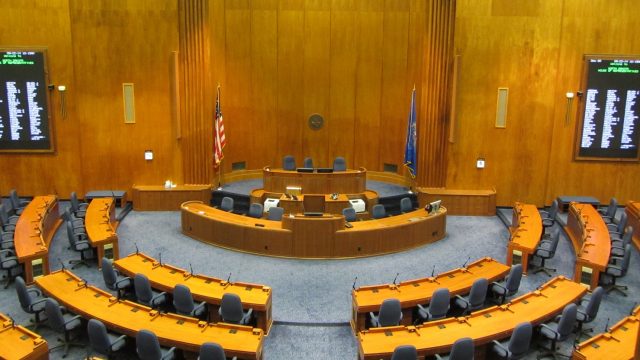Revising History: North Dakota Democrats Should Stop Blaming Their Plight On Republican Cheating

The North Dakota House of Representatives sits empty. (FNS Photo by Mike Nowatzki)
With North Dakota Democrats in utter disarray – don’t take my word for it, that’s what liberal columnist Lloyd Omdahl writes in his column today – there seems to be a narrative developing among the state’s leftists which blames the party’s malaise on Republican cheating.
Back in February it was liberal columnist Mike Jacobs who blamed Democratic failures on Republican deck stacking.
“They stacked the deck in their favor in two ways,” Jacobs wrote of Republicans. “The first was to lengthen the terms of House members to four years rather than two, with House and Senate members from the same district elected in the same election year. The second was to divide the state offices between ballots, with some elected in the presidential year and others in the off year. Both of these moves protected incumbents.”
This is nonsense, not the least because those changes to the ballot passed with large bi-partisan majorities.
The constitutional amendment was HCR3010 which was passed in the 1994 legislative session. It was sponsored by two Republicans – Rep. Grant Brown of Dunn Center and Matt Klein of Minot – and a Democrat, Rep. Jim Coats of Mandan. The House voted 74-22 to put the amendment on the ballot. In the Senate the vote was 30-18 in favor.
These were not party-line votes as you can see from the House and Senate journals.
[mks_pullquote align=”right” width=”300″ size=”24″ bg_color=”#ffffff” txt_color=”#000000″]…Jacobs says these measures represent Republicans stacking the deck, and yet both measures had strong Democratic backing. Jacobs is guilty of attempting some convenient historical revision, I think.[/mks_pullquote]
In the House, 15 Republicans and seven Democrats voted against the amendment, while 14 House Democrats voted in favor of it, including the Democratic minority leader, Bill Oban, and his assistant, Lee Kaldor. In the Senate, nine Republicans and nine Democrats voted against the amendment, while 12 voted for it, including Tim Mathern, the Democratic floor leader, and Aaron Krauter, his assistant.
For Jacobs to write that Republicans “stacked the deck” by giving House members four year terms is simply inaccurate. The legislation was bi-partisan both in its genesis and in the majorities which passed it.
As to Jacobs’ second claim, the constitutional amendment splitting up the ballot for statewide elections was passed by the 1999 Legislature. SCR4017 was sponsored by five Republicans and one Democrat, Rep. Lois Delmore of Grand Forks. The lead sponsor was Wayne Stenehjem, who was serving in his last legislative session at the time. He had introduced a similar constitutional amendment during the 1997 session which was not successful.
The amendment was approved 46-0 in the Senate, per the journal. Obviously the Democratic senators voted for it.
The amendment was approved 75-14 in the House (journal entry). Of the 14 No votes, 12 were Republicans. The two Democrats opposed were Rep. Audrey Cleary, D-Bismarck, and Rep. Doug Lemieux, D-Rolette. The Republicans against were Wes Belter, Jim Boehm, Tom Brusegaard, Rex Byerly, Al Carlson, Jack Dalrymple, Jeff Delzer, Mick Grosz, Keith Kempenich, Kim Koppelman, Jon Nelson and Blair Thoreson.
Both of these constitutional measures were also passed by a majority of voters, which all constitutional amendments in North Dakota must be.
Again, Jacobs says these measures represent Republicans stacking the deck, and yet both measures had strong Democratic backing. Jacobs is guilty of attempting some convenient historical revision, I think.
[mks_pullquote align=”left” width=”300″ size=”24″ bg_color=”#ffffff” txt_color=”#000000″]If Omdahl wants to claim that gerrymandering has been to Republican advantage, where’s the data to support it? It seems redistricting has had little impact on the makeup of the Legislature, and to the extent you can say that Republican-controlled redistricting has had an impact, it has been negative almost exclusively for Republicans.[/mks_pullquote]
Which brings us to Omdahl’s column today where he accuses Republicans of having “gerrymandered the legislative districts so that eight could be challenged for violating the constitutional requirement that districts be compact and contiguous.”
If that’s true, it’s hard to discern the electoral advantage for Republicans. After the last two rounds of redistricting Republicans have lost seats in the Legislature.
North Dakota re-draws legislative district lines after every 10-year census. The last district map was approved by lawmakers in November of 2011 during a special session. In the two election cycles since – 2012 and 2014 – Republicans have lost three seats in the state Senate, though they gained two seats in the state House.
After the 2001 redistricting the number of legislative districts were downsized, but Republicans took the bigger hit. In the Senate both Republicans and Democrats lost one seat after the 2002 elections. In the House Republicans lost three seats while Democrats lost 1.
Republicans did gain 7 House seats after the 1991 redistricting, but that redrawing of the lines took place when Republicans held only on the House and one statewide office (Auditor). Republicans also lost two seats in the state Senate.
If Omdahl wants to claim that gerrymandering has been to Republican advantage, where’s the data to support it? It seems redistricting has had little impact on the makeup of the Legislature, and to the extent you can say that Republican-controlled redistricting has had an impact, it has been negative almost exclusively for Republicans.
To be fair to Omdahl, he does go on to write that “Republicans deserve only partial credit for the decline of the Democratic Party.” The rest of the blame goes to Democrats themselves and national political trends.
Even so, much as with Jacobs’ claims, I think Omdahl is revising history to give himself and his ideological fellow travels an excuse.




